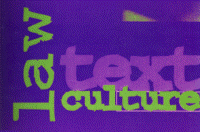Abstract
The printing of theatre — theatrum imprimatur, just to flaunt a little — was accompanied by a theatricalisation of print. The new technology of the production of books brought with it not only an exponentially greater quantity, but also an increased visibility, of scholarly works and religious and legal texts particularly. Pamphlets, typescripts, books flooded the markets and were everywhere on view. Early print also had a striking dimension of performance and play. Aviaries of angels and other devotional and instructional figures adorned the religious manuals and modelled the proper persona, the ontic self, that the subject should play. Early law texts had coloured graphics, emblems, ‘devises’, as well as schemata, charts, portraits and mottos. Legal being too had its visible and printed figures, the image of the apposite propositus that accompanied the ceremonies of the norm and their demands for honour and role.
How to Cite:
Goodrich, P., (2010) “Theatres of the Book: Covering, Flaunting, Marketing, Author and Text”, Law Text Culture 14(1), 357-383. doi: https://doi.org/10.14453/ltc.569
Downloads:
Download PDF
View PDF
385 Views
917 Downloads

